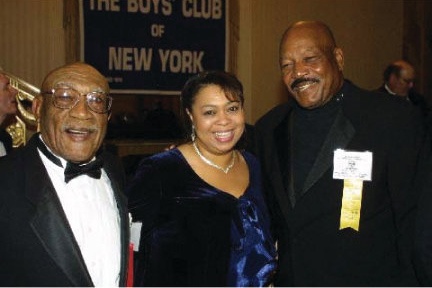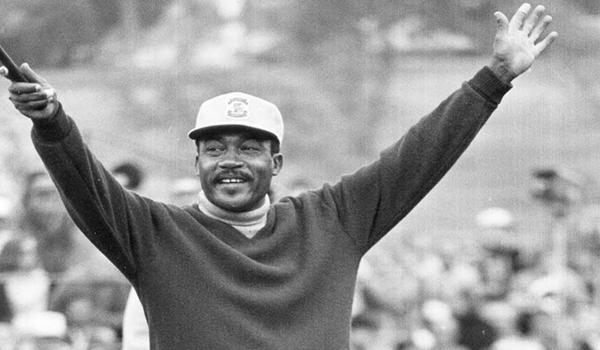We Did It! Charlie Sifford to Jackie Robinson, on receiving his PGA Tour card in 1960.
April 15th is Jackie Robinson Day in MLB. But his efforts on behalf of a friend helped integrate professional golf and show the power of the press.
In 1960, Charlie Sifford Sr. became the first Black player to earn his tour card, and later nabbed—a promethean win at the Greater Hartford Open at Wethersfield in 1967 at age 45. What might be less well known is that all this might not have been possible without the power of the press and the support of an even bigger sports star: Jackie Robinson.
Charlie Sifford Jr. is now 76, can shoot his age, and is one of the notables keeping his father’s legacy alive, though for the finer points of this history, he defers to his father’s long-time friend, Russell Crockett. In a voice as gruff as his dad’s cigar-eaten pipes, he tells me, “More than anyone alive, Russell can speak to Robinson’s place in my father’s achievement.”
Mr. Crockett is Chair of the Sifford Estate and runs the Sifford Scholars Program in association with the Cobbs Creek Foundation. Though known as the ‘Jackie Robinson of Golf,’ Russell notes, with a laugh, Charlie Sr. preferred the moniker ‘Doctor Sifford.’ St Andrews University awarded a Doctor of Laws degree to Sifford in 2006.
“It was in 1947,” Russell begins, “after his tour in World War II, when Charlie got back to golfing. He had a conversation with Jackie Robinson about his plans to become a full-time golf professional—it would be critical advice that Sifford would refer back to often. Jackie had one question for him. Are you a quitter? If you aren’t a quitter, then give it a shot. Sifford loved golf so much that there was nothing that would stand in his way. Like Robinson, as a Black man, he would have to endure a lot, he did and he never quit.”
From that conversation in 1947 to the 1960s, after his baseball playing days, Robinson stood by Charlie Sifford as he pushed to integrate professional golf. In a series of columns for The New York Post, from 1959 to 1963, Robinson pushed for equality in sports. He wanted his friend to be allowed to earn a living based on ability, not on race. The breakthrough came in 1960.
In the New York Post of March 30, 1960, Mr. Robinson writes, “Charlie Sifford phoned me from California yesterday to say: ‘We did it!’ Sifford, who is the top Negro golf pro but who has been barred from many tournaments for lack of approval by the Professional Golfers Assn., told me he had just had word that his ‘approved player’ card is on the way.”
Robinson did not stop there. In another column we find this: “And though the PGA has yet to remove the un-American ‘Caucasians only’ clause . . . I am greatly hopeful.” Robinson called on the membership to rescind the discriminatory requirement at their annual meeting that November, 1961. They did.
While #42 was not the only one pushing for golf’s integration—Althea Gibson and Joe Louis and many others all had a bite at the apple—there’s no denying that Robinson’s newspaper platforms helped bring on the reversal of the Caucasian-only rule.
Even then Robinson was not done. A 1963 column in the New York Post (February 23) advocated for a boycott of certain sponsors for not inviting a top African-American golfer: “Why should the buying power of our race be used to support manufacturers who do not give just due to the Negro? . . . Let’s give our champions some real backing by refusing to support businesses which choose to ignore our existence.”
As late as 1967, Robinson continued to advocate for his friend’s inclusion at the highest levels of the game. In a column for the Chicago Defender (Sept. 16, 1967), “Growth of the Negro in the World of Golf,” Robinson urged The Masters to invite Sifford. This discussion would grow even more heated in 1969, with Bobby Jones and Lee Murray of the LA Times squaring off over an invite for Sifford. As is settled history, this was not resolved until Lee Elder’s appearance in 1975. Sifford never received an invitation to the April test at Augusta.
Undaunted, Charlie Sr. played through it all, famously winning in Hartford in 1967. And while denied a shot at titles during what would arguably be an athlete’s prime (receiving his tour card at 37), he went on to win the 1969 Los Angeles Open, the 1971 Sea Pines Championship, the 1975 PGA Senior Championship, and the 1980 Suntree Senior PGA Tour Classic.

Divine intervention is involved in Mr. Crockett’s way of seeing Doctor Sifford’s journey. “Crazy things happened,” Crockett says. During World War II, Sifford was in Japan in one of the bloodiest battles of World War II (Okinawa). His infantry job was to put up telephone poles for communications. “He said there were many days he’d be on the poles and there’d be fire fights in that region. He could have been killed at any time.”
And what about driving around the Deep South in the 40s with singer Billy Eckstine and his band, one of the few integrated big bands at the time? “The only thing Mr. Eckstine loved more than singing was golf,” Crockett laughs, noting that Eckstine took Sifford on as driver, protector, and golf instructor until Charlie began to make some dough. “They were inseparable,” Mr. Crockett continues. “Mr. B kept Charlie at his side, and Charlie sent his wages back to Rose and Charlie Jr. in Philly. Miles Davis, Joe Louis, Jackie Robinson, all of them made Sifford’s career possible.”
It’s no coincidence the Sifford Scholarship Fund runs in association with The Cobbs Creek Foundation. Cobbs is the Philadelphia course where Sifford honed his skills, a course that to this day welcomes golfers of every race, gender, and ability. Tiger Woods, who called Sifford Sr. the grandfather he never had, is building only the second TGR learning center in the current restoration and reconfiguration at Cobbs, which is being overseen by Jim Wagner and Gil Hanse. The TGR Center is slated to open April 1, 2025.
“Charlie would spend close to 16 years there,” Crockett says about Cobbs, recalling that Sifford and his friend Slim Ferguson left North Carolina, looking for more friendly climes for young, Black golfers. “He and Slim landed a job in shipping at Nabisco,” Crockett muses on the Philadelphia years. “The Doctor and Slim learned you could take the train out to Cobbs, where all could play.”

There Sifford would run with Howard Wheeler, win the first of his six UGA titles, and attract the support not only of Billy Eckstine, but Joe Louis and others, including #42. Cobbs was home and Philadelphia where Charlie married Rose Crumbley. He and Slim both started families, and Hugh Wilson’s layout along a West Philadelphia creek would be the cradle where Sifford mastered the game he so loved.
“That love was deep,” Russell sighs. Crockett observed a conversation between Jackie Burke and Sifford at Champions in Houston. Burke told Sifford to make sure he had a blade putter in his casket. “When we get up to heaven, Jimmy Demaret is gonna have those greens running fast.” Mr. Crockett laughs as he notes, “The doctor spoke with the enthusiasm of a 6- or 7-year-old talking about golf. That’s why he was loved. Burke and Demaret, Jack, Arnold, Gary Player, they all loved Charlie.”

Into that pantheon include Jackie Robinson, whose love for his friend was strong enough to turn the tide of history.
The Travelers Championship is the inaugural sponsor of the Sifford Scholars Program. For more information see: https://siffordscholars.com
Charlie Sifford Jr., the first of two children to Rose and Charlie Sifford Sr., lives in Cleveland, Ohio. Mark Wagner is the author of Native Links, The Surprising History of Our First People in Golf (Back Nine Press, 2024).
The Travelers Championship is the inaugural sponsor of the Sifford Scholars Fund. For more information see: https://siffordscholars.com







